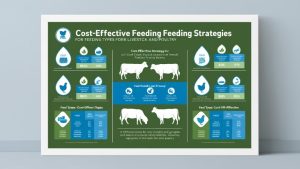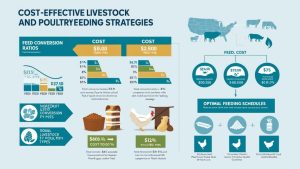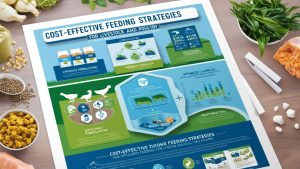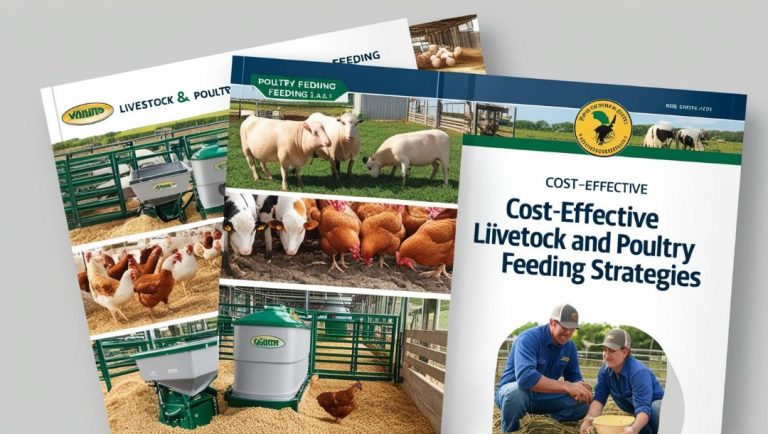Feeding is one of the most significant expenses in livestock and poultry farming, often accounting for up to 70% of total production costs. Implementing cost-effective feeding strategies is essential to maximize productivity while minimizing expenses. These strategies involve optimizing feed formulation, utilizing alternative feed sources, reducing waste, and adopting efficient feeding techniques.
This article explores practical and sustainable approaches to feeding livestock and poultry while maintaining high production efficiency.
Click HERE to join our WhatsApp group chat
Understanding Cost-Effective Feeding
a) Importance of Cost-Effective Feeding
Reduces overall production costs while maintaining or improving productivity.
Enhances animal health and growth by providing balanced nutrition.
Contributes to environmental sustainability by reducing feed wastage and resource use.
b) Key Principles of Cost-Effective Feeding
Formulating balanced diets with optimal nutrient composition.
Sourcing affordable and locally available feed ingredients.
Reducing feed wastage through improved management practices.
Implementing precision feeding to meet specific nutritional needs.
READ ALSO: Swine Fever: Symptoms, Prevention, and Treatment
Feed Formulation for Cost Savings

a) Balancing Nutrient Requirements
Provide essential nutrients such as proteins, carbohydrates, fats, vitamins, and minerals.
Adjust feed composition based on the growth stage and production goals (e.g., meat, milk, or egg production).
Use feed additives and supplements to improve digestion and nutrient absorption.
b) Using Least-Cost Formulation
Utilize software or expert advice to formulate the most cost-effective feed.
Incorporate alternative ingredients without compromising nutritional value.
Adjust rations based on seasonal availability of ingredients.
c) Incorporating By-Products and Alternative Feeds
Use agro-industrial by-products like rice bran, wheat bran, and brewers’ grains.
Incorporate food waste and kitchen scraps where permitted.
Explore unconventional feed sources like insect meal, algae, and food-processing residues.
READ ALSO: Sheep Farming: Wool, Meat, and Dairy Production
Alternative and Locally Available Feed Sources
a) Plant-Based Alternatives
Legume Forages: Alfalfa, clover, and soybean meal provide protein at a lower cost.
Root Crops: Sweet potatoes, cassava, and yam can replace expensive grains.
Oilseed Cakes: Sunflower, palm kernel, and groundnut cake serve as affordable protein sources.
b) Animal-Based Protein Alternatives
Insect-Based Feeds: Black soldier fly larvae and mealworms offer sustainable protein sources.
Fish Meal Substitutes: Fermented fish waste and silage can serve as cost-effective alternatives.
Bone and Blood Meal: By-products from slaughterhouses enhance feed quality at a lower cost.
c) Fermented and Hydroponic Feeds
Fermented Feeds: Improve digestibility and nutrient availability while reducing feed costs.
Hydroponic Fodder: Grows quickly with minimal land use, providing a rich source of nutrients.
Silage Making: Converts green fodder into high-energy feed for ruminants.
READ ALSO: Importance of Fiber and Roughages in Ruminant Nutrition
Feed Management Practices to Reduce Waste

a) Proper Storage and Handling
Store feed in dry, well-ventilated areas to prevent spoilage and mold growth.
Use sealed containers to protect feed from rodents and pests.
Rotate feed stocks to ensure older feed is used first.
b) Feeding Techniques for Minimal Waste
Use appropriate feeders to reduce spillage and contamination.
Feed animals at consistent times to prevent overeating or selective feeding.
Monitor feeding behavior and adjust rations accordingly.
c) Preventing Overfeeding and Underfeeding
Provide feed based on precise nutritional requirements to avoid excess costs.
Conduct regular weight and growth assessments to adjust feeding plans.
Train farm workers on proper feeding methods to ensure efficient feed utilization.
READ ALSO: Fattening Strategies for Beef Production
Precision Feeding for Efficiency
a) Benefits of Precision Feeding
Ensures animals receive the right amount of nutrients, reducing waste.
Lowers feeding costs by optimizing portion sizes and nutrient balance.
Reduces environmental impact by limiting nitrogen and phosphorus excretion.
b) Technologies for Precision Feeding
Automated Feed Dispensers: Provide accurate portions and reduce labor costs.
Nutrient Monitoring Systems: Analyze feed composition and animal growth data.
Smart Feeding Apps: Help farmers calculate rations and adjust feed schedules.
c) Phase Feeding Strategies
Adjust feeding programs based on growth stages and production needs.
Use starter, grower, and finisher feeds in poultry and pig farming.
Implement lactation-specific diets for dairy and breeding animals.
READ ALSO: Ration Balancing for Maximum Productivity
Sustainable Feeding Practices

a) Reducing Feed Conversion Ratios (FCR)
Select genetically improved breeds with higher feed efficiency.
Enhance gut health with probiotics and prebiotics for better digestion.
Improve pasture management for grazing animals to increase natural feed intake.
b) Integrating Forage-Based Systems
Use rotational grazing to maintain pasture quality.
Grow nitrogen-fixing plants to enrich soil and provide additional feed sources.
Mix grasses and legumes for better nutrient balance in grazing systems.
c) Water-Efficient Feeding Methods
Provide clean and adequate water to enhance feed utilization.
Use water-saving systems such as drip irrigation for hydroponic fodder production.
Reduce water waste by fixing leaks and using efficient watering systems.
READ ALSO: Stress Management in Livestock
Economic Analysis of Feeding Strategies
a) Calculating Cost Per Unit of Production
Determine feed costs per kilogram of weight gain, liter of milk, or dozen eggs.
Compare different feed options based on cost-benefit analysis.
Track changes in feed costs and adjust feeding strategies accordingly.
b) Evaluating Return on Investment (ROI)
Assess the profitability of alternative feeding strategies.
Analyze production efficiency to ensure cost-effective nutrition.
Adjust feed formulations to maintain optimal performance and economic returns.
c) Record-Keeping for Feed Management
Maintain detailed records of feed purchases, formulations, and usage.
Track feed-related expenses and identify areas for cost reduction.
Use farm management software for better financial tracking and analysis.
Conclusion
Cost-effective feeding strategies are vital for improving profitability and sustainability in livestock and poultry farming. By utilizing alternative feed sources, reducing waste, implementing precision feeding, and optimizing nutrient management, farmers can significantly lower feed costs while maintaining high production efficiency. Regular evaluation of feeding strategies ensures that livestock receive optimal nutrition at the lowest possible cost, contributing to the long-term success of the farming enterprise.
READ ALSO: Supplementary Feeding for Sheep and Goats
Supplementary feeding plays a crucial role in the nutrition and productivity of sheep and goats, particularly in regions where natural pasture is insufficient due to seasonal changes, drought, or poor-quality forage. Proper supplementation ensures optimal growth, reproduction, milk production, and overall health of small ruminants. Understanding the types of supplementary feeds, feeding strategies, and their benefits can help…
READ ALSO: Climate Change and Its Impact on Livestock and Poultry
Climate change is one of the most pressing challenges facing the global agricultural sector today, with livestock and poultry production being highly vulnerable to its effects. Rising temperatures, unpredictable weather patterns, increased frequency of extreme weather events, and shifts in disease prevalence are all factors that influence the health, productivity, and sustainability of livestock and poultry farming…
Click HERE to join our WhatsApp group chat

